Fifteen years ago, at the end of a Green-Wood tour that I was leading, a gentleman approached me, pulled out a photograph of a drawing, and asked me if there was a monument at Green-Wood that looked like that. I immediately recognized it as the Pierrepont Family Memorial. It turned out that the man with the photograph was Norman Brosterman, a collector and dealer who had purchased a cache of the Upjohn architectural firm’s drawings that had been found in a New Jersey attic. Norman generously allowed me to photograph the plans and to reproduce one of them in my book, Brooklyn’s Green-Wood Cemetery: New York’s Buried Treasure. If you have a copy, take a look at page 9–that is one of the drawings at top right. I must admit, you really can’t see it very well there–my photograph of it was not very good, and we really didn’t do it justice there. If you don’t have a copy of the book, order it here right now.
The Pierrepont Family Memorial, which likely dates from the 1840s (Henry Pierrepont purchased Green-Wood lots one through 8 in 1842), is an important Green-Wood piece. It was designed by Richard Upjohn, one of America’s first architects, the first president of the American Institute of Architects, and the man who designed Trinity Church (1846) which still stands on Broadway at the head of Wall Street in Manhattan. Upjohn was Green-Wood’s architect in its early years–he designed the Receiving Tomb, the Main Gate Arches, and several shelters that are long gone.
And, the fact that this monument is for the Pierrepont family is also significant. Henry Evelyn Pierrepont (1808-1888) is the father of Green-Wood Cemetery.

He toured cemeteries in Europe, and America’s first rural cemetery (Mount Auburn, in Cambridge, Massachusetts, in 1832), when Green-Wood was just a dream of his. Soon after the City of Brooklyn was incorporated in 1834, Pierrepont was appointed to its roads commission. He made sure that no roads were laid out through the land that he hoped would soon become Green-Wood Cemetery. And it was Pierrepont who, on horseback, rode the Gowanus Heights with David Bates Douglass (1790-1848), the engineer who would become Green-Wood’s designer, to pick the best location for a rural cemetery.
The Pierrepont Monument stands atop a man-made hillock, with a view in all directions. It is one of the few man-made hills at Green-Wood–and it was built up to honor Henry Pierrepont. His father, Hezekiah (1768-1838), who developed Brooklyn Heights as a New York City suburb, and his mother Anna (1782-1838), heir to huge tracts of land in the Adirondacks, are also interred there.
Upjohn’s construction material of choice was brownstone. So, it is no surprise that the Pierrepont Monument is made of that material. That, however, created some problems for the survival of this monument. Brownstone is a soft, stratified material which tends to deteriorate over time. Joints open up, pieces break off, stone deteriorates.
This monument has been a part of our “Saved In Time” program–“a program to preserve the historic monuments of Green-Wood Cemetery”– since that program was launched several years ago. Though a good number of the “Saved In Time” monuments have been restored, the Pierrepont Monument remained untouched until recently. But, about a year ago, Ann Gaffney, one of our devoted trustees, made arrangements for two Pierrepont descendants to tour Green-Wood. Afterwards, our president, Rich Moylan, was able to pursuade them to go 50/50 with the cemetery on contributing funds for the restoration of the monument and lot.
Kate Ottavino, a leading expert in conservation and preservation, began work on the Pierrepont Monument recently. As she did so, we realized that it would be good to have copies of the original drawings on hand. So, I contacted Norman Brosterman, who told me that he had sold the Upjohn drawings to the Library of Congress in 1996. I went online and found those drawings in its catalogue. However, the 323 drawings from the Upjohn firm were listed as unprocessed. I thought that was going to be a problem. But I left a message in the “Ask the Librarian” folder and, just three days later, the Library of Congress e-mailed the drawings to me. Talk about your government at work for you.
So, here they are, the Upjohn drawings, in all their glory!
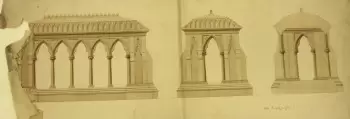
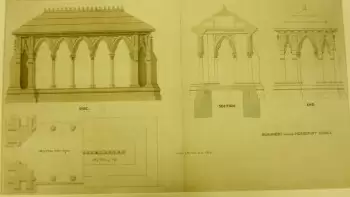
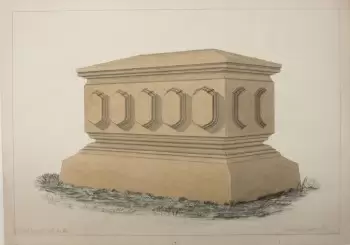
And here’s some of the work that was being done on the monument last week, and that contiues: gentle washing (to remove dirt and biological growth) and regrading (to expose the stone curb around the monument and to insure drainage away from the monument).
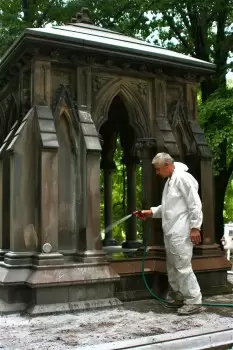
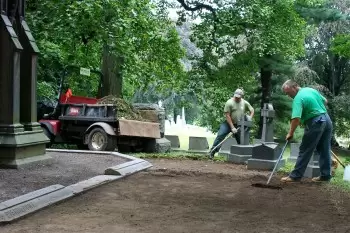
Dear Mr. Richman,
I read with great interest your article on the Pierrepont Family Memorial, which my brother sent me.
My fourth great-grandparents are Hezekiah Beers Pierrepont and Anna Marie Constable Pierrepont, who are entombed in the Pierrepont sarcophagus. They are the parents of Henry Evelyn Pierrepont, who you refer to in your article as the Father of Green-Wood. I am descended from one of Hezekiah and Anna Marie Pierrepont’s daughters, Harriet Constable Pierrepont. She and her husband,E.J.Bartow, were the sole benefactors of the Church of the Holy Trinity, which I believe is on Pierrepont Street in Brooklyn. Today, the church is called St. Ann and Holy Trinity.
My family has always been interested in genealogy and has tremendous respect for those who came before us. Several years ago, we bought your book and have enjoyed reading it.
We live in Tennessee but have made two trips to Green-Wood this past year. In addition to Hezekiah and Anna Marie, all of my relatives on my father’s side are buried in the hill below the Pierrepont sarcophagus. Interestingly, and perhaps inaccurately, we have always thought the Pierrepont Memorial was commissioned by Hezekiah and his wife to honor their family and to allow all of their children’s descendants to be buried together on the hill.
We were unaware of the program “Saved in Time,” but are most grateful that you have chosen to save the Pierrepont Memorial. How wonderful that two Pierrepont descendants have chosen to help support the restoration!
Thank you for your role in preserving Green-Wood.
With all good wishes,
Roberta
Dear Roberta,
First, like you, I celebrate reading this history of Green-wood and the role the Pierreponts had in its development.
I too am a direct descendant through HEP’s son Robert Low Pierrepont & Kathryn Reed Pierrepont, their son John Jay Pierrepont, and my mother Bennett Pierrepont Jack.
HEP’s wife was Anna Maria Jay, granddaughter of John Jay.
When you are planning your trip to Green-wood, where numerous Bartows are buried, build in an extra day or two to visit the John Jay Homestead in Katonah, NY about a 75 minute drive from Manhattan, and the Jay Heritage Center in Rye, NY, about an hour from midtown. The Homestead is the home John Jay built for his retirement. The Jay Heritage Center is a Greek Revival built by Peter Augustus Jay on the site of the farmhouse where John Jay was born.
Both are great American historic sites and chockerblock of family history.
Best, Griff Samples
Jeff: I was delighted to read more about the Pierrepont Family, including Henry Evelyn Pierrepont and his connection to Green-Wood with the Pierrepont Memorial. You and your Saved in Time Program are to be commended for caring enough about history to put efforts and funds into its preservation.
I too am a descendent of Hezekiah Beers Pierrepont via Wm Constable Pierrepont, Anna Maria Pierrepont [White] and Wm Pierrepont White, who was my grandfather. I look forward to visiting Brooklyn and will certainly put Green-Wood Cemetery on my growing list of places to visit.
Thank you for your blog and for all you do to educate us about the history of Green-Wood.
Best Wishes,
Deborah
Thank you!